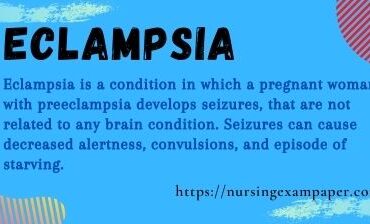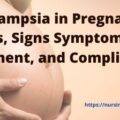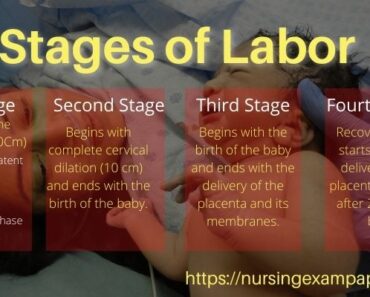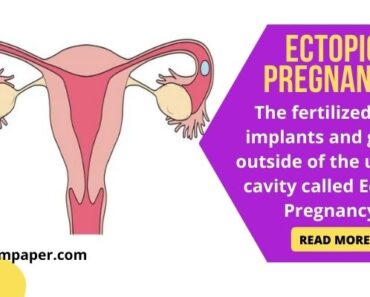This is a severe complication of pregnancy that arises from preeclampsia, a condition characterized by high blood pressure and excess protein in the urine. It is marked by the onset of seizures in a pregnant woman, which are not related to other brain conditions. Here we are providing the details of the definition of eclampsia and its causes, symptoms, and treatment of eclamptic patients along with its complications.
Eclampsia can be followed by high blood pressure, and excess protein in the urine at the time of pregnancy. It is a condition in which a pregnant woman with preeclampsia develops seizures that are not related to any brain condition. Seizures can cause decreased alertness, convulsions, and episodes of starving. Based on the onset of seizures, it is divided into three categories. antepartum (before delivery), intrapartum (During delivery), and postpartum (after delivery).
Causes of eclampsia
The exact cause is not fully understood, but several factors are believed to contribute to its development. These factors are related to the underlying condition of preeclampsia and may include:
- Neurological Factors
- Brain and Nervous System: Although the direct link is not completely clear, neurological changes associated with eclampsia may involve abnormal brain activity or altered brain function that leads to seizures.
- Genetic History
- Family History: Women with a family history of preeclampsia or eclampsia are at higher risk. Certain genetic factors may predispose individuals to these conditions.
- Diabetes and High Blood Pressure
- Pre-existing Conditions: Women with pre-existing diabetes or high blood pressure are at increased risk. These conditions can exacerbate or contribute to the development of preeclampsia and subsequently eclampsia.
- Kidney Disease
- Pre-existing Kidney Conditions: Chronic kidney disease can affect the body’s ability to manage blood pressure and protein levels, increasing the risk of developing preeclampsia and eclampsia.
- Pregnancy Age
- Early Age: Pregnant women who are very young (typically under 20 years old) may be at higher risk.
- Older Age: Women over the age of 35 are also at an increased risk for preeclampsia and eclampsia.
- Obesity
- Excess Weight: Obesity is a significant risk factor for preeclampsia and eclampsia, as it can contribute to high blood pressure and other complications during pregnancy.
- IVF Pregnancy
- In Vitro Fertilization (IVF): Pregnancies achieved through IVF may have a slightly higher risk of preeclampsia and eclampsia, although the exact reasons for this association are not fully understood.
- Blood Vessel Problems
- Abnormal Blood Vessel Development: Problems with the development and function of blood vessels, particularly those that supply the placenta, can lead to inadequate blood flow and contribute to the development of preeclampsia and eclampsia.
Additional Factors
- Multiple Pregnancies: Carrying more than one baby (multiple gestations) can increase the risk of developing preeclampsia and eclampsia.
- Autoimmune Disorders: Certain autoimmune conditions may also increase the risk.
- Understanding these risk factors helps in identifying women who may be at higher risk for developing preeclampsia and eclampsia, allowing for closer monitoring and early intervention to improve outcomes for both mother and baby.
The Pregnancy Changes in Mother & Baby Body
Symptoms of eclampsia
The symptoms of eclampsia are closely related to those of severe preeclampsia, but eclampsia specifically includes the additional complication of seizures. Here is a detailed list of symptoms for both preeclampsia and eclampsia:
- Seizures
- Main Symptom: The defining symptom of eclampsia is the occurrence of seizures, which can be generalized convulsions and may lead to loss of consciousness. Seizures are a critical indicator that the condition has progressed from preeclampsia to eclampsia.
- High Blood Pressure
- Elevated Blood Pressure: Severe high blood pressure (hypertension) is a key feature in both preeclampsia and eclampsia. Typically, blood pressure readings of 140/90 mmHg or higher are observed.
- Swelling
- Face and Hands: Sudden or severe swelling (edema) in the face, hands, and sometimes the legs can occur.
- Headache
- Severe Headaches: Intense and persistent headaches that do not respond to usual pain relief measures.
- Weight Gain
- Rapid Weight Gain: Sudden weight gain, often due to fluid retention, is common.
- Nausea and Vomiting
- Gastrointestinal Distress: Persistent nausea and vomiting may occur, sometimes making it difficult for the affected woman to keep food or fluids down.
- Blurry Vision and Loss of Vision
- Visual Disturbances: Blurred vision, seeing spots or flashes, or even temporary loss of vision.
- Loss of Consciousness
- Unconsciousness: During seizures, there may be a loss of consciousness, making it crucial to seek immediate medical attention.
- Agitation
- Mental State Changes: Increased agitation, confusion, or altered mental state may accompany the onset of seizures.
- Proteinuria
- Excess Protein in Urine: High levels of protein in the urine, indicating kidney dysfunction, is a key symptom of preeclampsia and can be present in eclampsia as well.
Additional Symptoms Related to Eclampsia
- Abdominal Pain: Severe pain in the upper right side of the abdomen, often due to liver involvement.
- Shortness of Breath: Difficulty breathing may occur if fluid accumulates in the lungs.
Managing Symptoms
Immediate medical intervention is essential to manage eclampsia. The treatment focuses on controlling seizures, managing high blood pressure, and addressing any complications to ensure the safety of both the mother and the baby.
If any of these symptoms are present, especially in a pregnant woman with preeclampsia, it is crucial to seek emergency medical care to prevent severe complications and ensure appropriate management.
The Pregnancy Period Third Trimester
Diagnosis
- Clinical Assessment
- Patient History and Symptoms: A detailed medical history and evaluation of symptoms, including high blood pressure, swelling, headaches, visual disturbances, and seizures.
- Physical Examination: Checking for signs of swelling, assessing neurological status, and monitoring vital signs.
- Blood Pressure Measurement
- Elevated Blood Pressure: Blood pressure is measured regularly. In eclampsia, blood pressure readings are typically 140/90 mmHg or higher. Severe hypertension is a hallmark of preeclampsia and eclampsia.
- Urine Tests
- Proteinuria Testing: A urine test is conducted to check for excess protein in the urine, which is indicative of kidney dysfunction. This may involve:
- Dipstick Test: A quick test using a dipstick that changes color in the presence of protein.
- 24-Hour Urine Collection: More accurate measurement of the total amount of protein in the urine over a 24-hour period.
- Proteinuria Testing: A urine test is conducted to check for excess protein in the urine, which is indicative of kidney dysfunction. This may involve:
- Blood Tests
- Complete Blood Count (CBC): To assess for signs of hemolysis, low platelets (thrombocytopenia), or other blood abnormalities.
- Liver Function Tests: To check for liver involvement or damage.
- Kidney Function Tests: To assess kidney function, including serum creatinine and blood urea nitrogen (BUN) levels.
- Neurological Evaluation
- Assessment of Seizures: Evaluating the presence of seizures, their frequency, and duration. A neurological examination may be performed to assess the severity of neurological symptoms.
- Ultrasound
- Fetal Monitoring: Ultrasound may be used to monitor the health of the fetus, check for signs of distress, and assess fetal growth and development.
- Other Diagnostic Imaging
- CT Scan or MRI: In some cases, imaging studies may be used to rule out other causes of seizures or to assess brain involvement.
- Additional Tests
- Coagulation Profile: To check for blood clotting disorders that may be associated with severe cases of eclampsia.
Diagnostic Criteria
- Hypertension: Blood pressure ≥ 140/90 mmHg.
- Proteinuria: Presence of protein in urine, typically ≥ 300 mg per 24 hours.
- Seizures: Confirmed presence of generalized convulsions or seizures not attributed to other causes.
Monitoring and Follow-up
- Regular Monitoring: Continuous monitoring of blood pressure, urine output, and fetal well-being is essential.
- Ongoing Evaluation: Close observation and reassessment to ensure that treatment is effective and to monitor for any signs of worsening conditions.
Prompt diagnosis and treatment are crucial to managing eclampsia and preventing serious complications for both the mother and the baby.
Treatment of Eclampsia
Treatment is focuses on both managing the acute symptoms and addressing the underlying causes. The main goals are to control seizures, manage high blood pressure, and ultimately deliver the baby to resolve the condition. Here’s a detailed overview of the treatment strategies:
1. Delivery of the Fetus
- Definitive Treatment: The delivery of the baby is the most effective way to resolve it, as it addresses the underlying causes of the condition. Delivery often helps to alleviate the symptoms of eclampsia.
- Timing and Method: The timing and method of delivery will depend on the severity of the eclampsia, the gestational age, and the health of both the mother and the baby. If the mother’s condition is severe or if the baby is in distress, an urgent or emergency delivery may be necessary.
- Postpartum Management: In some cases, symptoms of eclampsia may continue or even worsen after delivery. Therefore, close monitoring and continued treatment are essential.
2. Magnesium Sulfate (MgSO4)
- Drug of Choice: Magnesium sulfate is the primary medication used to manage eclampsia.
- Seizure Control: It is effective in treating active seizures and preventing future seizures. Magnesium sulfate stabilizes neuronal membranes and reduces the likelihood of convulsions.
- Dosage and Administration: It is typically administered intravenously. The standard dosing regimen involves a loading dose followed by a continuous infusion, with careful monitoring of magnesium levels and signs of toxicity.
3. Antihypertensive Drugs
- Blood Pressure Management: Controlling high blood pressure is crucial in managing eclampsia and preventing further complications.
- During Pregnancy:
- Labetalol: Often used as a first-line antihypertensive medication in pregnant women due to its efficacy and safety profile. It is a combined alpha- and beta-blocker that helps lower blood pressure.
- After Delivery:
- Amlodipine: A calcium channel blocker used to manage blood pressure after delivery if needed. It is effective in controlling chronic hypertension and does not adversely affect lactation.
- During Pregnancy:
4. Supportive Care
- Monitoring: Continuous monitoring of maternal and fetal status, including blood pressure, urine output, and seizure activity.
- Fluid Management: Careful management of fluids to avoid complications like pulmonary edema.
- Magnesium Levels: Regular monitoring of serum magnesium levels to prevent toxicity.
- Neurological Assessment: Ongoing evaluation of neurological status to detect any complications early.
5. Additional Treatments
- Anticonvulsants: In addition to magnesium sulfate, other anticonvulsants may be used if seizures are not well-controlled or if magnesium sulfate is contraindicated.
- Pain Relief and Comfort Measures: Providing comfort measures, including pain relief, as needed.
6. Long-Term Management
- Postpartum Care: Follow-up care is essential to monitor for any long-term effects of eclampsia or preeclampsia and to manage any residual symptoms.
- Counseling and Education: Educating the mother about signs of potential recurrence in future pregnancies and the importance of regular prenatal care in subsequent pregnancies.
Complications and Considerations
- Persistent Symptoms: In some cases, symptoms may persist or develop postpartum, requiring ongoing treatment and monitoring.
- Organ Damage: Monitoring for any signs of organ damage or complications resulting from eclampsia, such as liver or kidney issues.
Overall, the treatment of eclampsia involves a multifaceted approach with a focus on immediate relief of symptoms, careful monitoring, and long-term management to ensure the health and safety of both the mother and the baby.
What Is Memory its Definition Parts
Complications
Eclampsia can lead to a range of serious complications, which can affect both the mother and the baby. Here’s a detailed overview of the potential complications associated with eclampsia:
- Preterm Birth
- Premature Delivery: To manage severe eclampsia and protect the health of both the mother and the baby, early delivery may be necessary. Preterm birth can lead to complications related to the baby’s underdeveloped organs and systems.
- HELLP Syndrome
- Severe Form of Preeclampsia: HELLP syndrome is a life-threatening complication characterized by Hemolysis, Elevated Liver enzymes, and Low Platelets. It often occurs in conjunction with severe preeclampsia or eclampsia and can lead to liver failure, bleeding disorders, and other serious issues.
- Placental Abruption
- Separation of the Placenta: Placental abruption occurs when the placenta detaches from the uterine wall before delivery. This can lead to heavy bleeding, reduced oxygen and nutrient supply to the baby, and can be a significant risk factor for fetal distress or stillbirth.
- Oligohydramnios
- Reduced Amniotic Fluid: Oligohydramnios is a condition where there is too little amniotic fluid surrounding the baby. It can be associated with poor fetal outcomes, including impaired lung development and compression of the umbilical cord, which can lead to further complications.
- Permanent Neurological Damage Due to Recurrent Seizures
- Long-term Effects: Recurrent seizures can cause neurological damage, particularly if they are not promptly and effectively managed. This can potentially lead to long-term neurological impairment for the mother.
- Intracranial Bleeding
- Brain Hemorrhage: Severe cases of eclampsia can lead to intracranial bleeding, which may occur during or after seizures. This can cause significant neurological damage and requires immediate medical intervention.
- Acute Renal Failure
- Kidney Dysfunction: It can cause acute renal failure or severe impairment of kidney function, characterized by a sudden decrease in the kidneys’ ability to filter waste from the blood. This condition requires urgent management and, in severe cases, may necessitate dialysis.
- Renal Insufficiency
- Chronic Kidney Issues: Beyond acute failure, there may be a risk of chronic kidney insufficiency, where the kidneys are not able to function optimally over the long term. This can result from severe damage sustained during the eclamptic episode.
Management of Complications
- Preterm Birth: Neonatal care in a specialized unit (e.g., NICU) to address issues related to prematurity.
- HELLP Syndrome: Immediate delivery and management of liver and platelet abnormalities.
- Placental Abruption: Close monitoring and possible emergency delivery to manage bleeding and fetal distress.
- Oligohydramnios: Monitoring and potential interventions to address amniotic fluid levels.
- Neurological Damage: Continuous monitoring and supportive care to address any long-term neurological issues.
- Intracranial Bleeding: Neurological assessment and management, potentially including imaging and intensive care.
- Acute Renal Failure: Kidney support measures and possible dialysis, with ongoing monitoring of kidney function.
- Renal Insufficiency: Long-term follow-up and management of kidney function.
Early recognition and prompt management of these complications are crucial to improving outcomes for both the mother and the baby. Regular monitoring and a multidisciplinary approach involving obstetricians, neonatologists, and other specialists are essential for managing the complex needs of patients with eclampsia.
Question Paper For Staff Nurse Exam
Nursing Management of Eclampsia
Managing eclampsia involves a combination of immediate care to stabilize the patient, ongoing monitoring, and supportive care. Here’s a detailed overview of the nursing management of eclampsia:
Immediate Management
- Ensure Safety:
- Protect the Patient: During a seizure, ensure the patient is in a safe position. Place the patient on their side to prevent aspiration and keep the airway clear. Use pillows or padding to prevent injury.
- Monitor Seizure Activity: Record the duration and characteristics of the seizure for documentation and treatment evaluation.
- Airway Management:
- Maintain Airway: Ensure the airway is clear and consider using an airway adjunct if necessary. Suction if needed to clear secretions.
- Medication Administration:
- Anticonvulsants: Administer magnesium sulfate as prescribed. Magnesium sulfate is the drug of choice for seizure prophylaxis and control in eclampsia. Monitor for signs of toxicity, such as decreased reflexes or respiratory depression.
- Antihypertensives: Administer medications to manage severe hypertension, such as labetalol, hydralazine, or nifedipine, according to the healthcare provider’s orders.
- Monitor Vital Signs:
- Frequent Monitoring: Continuously monitor blood pressure, heart rate, respiratory rate, and oxygen saturation. Regularly assess for signs of complications, such as pulmonary edema or renal impairment.
- Seizure Precautions:
- Seizure Pads: Use seizure pads on the bed rails to prevent injury.
- Side Rails: Keep the side rails up to protect the patient from falling out of bed.
Ongoing Management
- Assessment and Monitoring:
- Fetal Monitoring: Continuously monitor fetal heart rate and activity, as eclampsia can impact fetal well-being.
- Urine Output: Monitor urine output closely to assess kidney function and fluid balance. Report any decrease in output.
- Patient Education:
- Inform the Patient: Provide education to the patient and family about eclampsia, including the importance of medication adherence and recognizing signs of worsening conditions.
- Supportive Care:
- Fluid Balance: Administer intravenous fluids as prescribed to maintain adequate hydration and electrolyte balance. Monitor for signs of fluid overload.
- Nutritional Support: Provide adequate nutrition and monitor for any dietary restrictions or needs.
- Prepare for Delivery:
- Delivery Planning: Prepare for possible delivery if the eclampsia does not resolve or if the condition worsens. Coordination with obstetricians and other specialists is crucial.
- Post-Delivery Care: Continue to monitor the patient closely after delivery for any signs of complications related to eclampsia.
Post-Seizure Care
- Monitor Recovery:
- Postictal State: Assess the patient’s level of consciousness and neurological status after the seizure.
- Follow-Up: Ensure ongoing monitoring and follow-up of blood pressure, magnesium levels, and overall condition.
- Emotional Support:
- Provide Support: Offer emotional support to the patient and family, as eclampsia can be a traumatic experience.
Documentation
Detailed Records: Document all aspects of care, including seizure activity, medication administration, vital signs, and patient responses. Accurate documentation is crucial for ongoing care and legal purposes.








